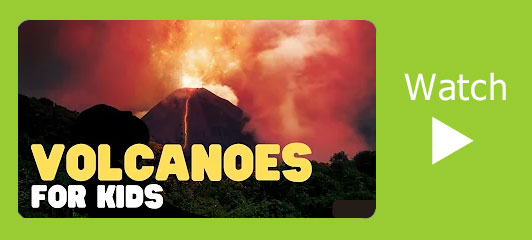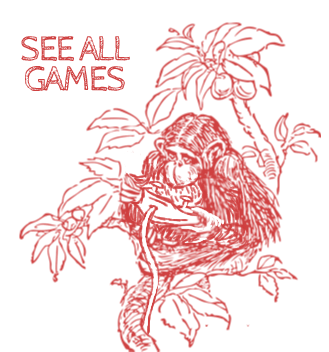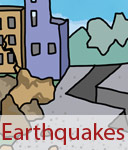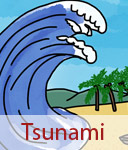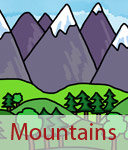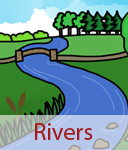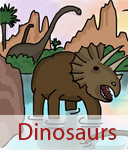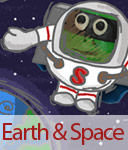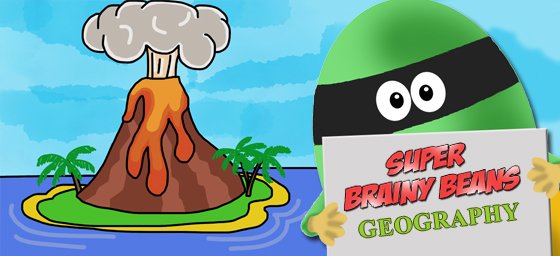
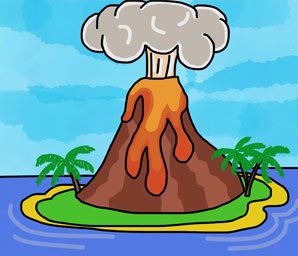
Volcanoes for kids
Volcanoes for kids learning in KS2 at Primary School. Homework help with what volcanoes are and how they are formed. Read about the impact of volcanoes on the environment.
What are volcanoes?
A volcano is an opening in the Earth’s surface where magma, gas, and ash escape from deep underground. On the outside, a volcano often looks like a mountain, but inside it is connected to a chamber of molten rock. When pressure builds up, the volcano can erupt, sending lava, smoke, and ash high into the sky. Some eruptions are small and gentle, while others can be violent and destructive.
 Volcanoes
VolcanoesA basic guide with pictures about Volcanoes.
How are volcanoes formed?
Volcanoes are usually found where tectonic plates meet. There are three main ways they can form:
-
When plates move apart (divergent boundaries):
If two tectonic plates slowly move away from each other, a gap forms in the Earth’s crust. Hot molten rock from below, called magma, rises up to fill the space. When this magma reaches the surface, it cools and hardens into rock. Over time, the build-up of these eruptions forms a volcano. A good example is along the Mid-Atlantic Ridge, where new land is still being created.
-
When plates collide (convergent boundaries):
Sometimes two plates crash into each other. When this happens, one plate is pushed down beneath the other into the mantle. The heat and pressure melt the plate, forming magma. This magma rises through cracks in the crust and may eventually erupt at the surface, creating a volcano. This type of boundary often creates some of the world’s largest and most dangerous volcanoes, such as those around the Pacific Ring of Fire.
-
Hot spots (in the middle of plates):
Not all volcanoes form at plate boundaries. Some appear in the middle of a tectonic plate, above a hot spot. A hot spot is an extra-hot part of the mantle where magma pushes up through the crust. Over millions of years, as the tectonic plate slowly moves, a chain of volcanoes can form. The Hawaiian Islands are a perfect example of this, created by a string of volcanoes formed over a hot spot.
Volcanoes come in different shapes and sizes, from tall, steep-sided cones to wide, flat shield volcanoes. They play an important role in shaping our planet, creating new land and rich soils that help plants grow, but they can also be very dangerous when they erupt.
 CBBC Newsround - Volcanoes
CBBC Newsround - VolcanoesFascinating facts on Volcanoes. Watch the Newsround volcano film, find out how volcanic ash affects aeroplanes and volcanoes are created.
 Volcano facts and information
Volcano facts and informationA full guide to Volcanos and how they are made.
 Volcano facts
Volcano factsFind out the history of volcanoes, what they look like and the damage they cause.
 National Geographic Kids - Volcano Facts
National Geographic Kids - Volcano Facts
Read facts on our explosive earth.
Which volcanoes are still active?
Not all volcanoes behave the same way. Some are very busy and erupt often, while others stay quiet for thousands of years.
Volcanoes that are no longer able to erupt are called extinct volcanoes. These are safe now and will never erupt again. Sometimes they just look like ordinary mountains because grass, trees, and even towns can grow on them.
Volcanoes that still erupt are called active volcanoes. An active volcano doesn’t have to erupt every day or every year—some of them can go thousands of years before erupting again. Even if it looks peaceful on the outside, it is still connected to hot magma deep underground.
Then there are volcanoes that are dormant, which means “sleeping.” These volcanoes haven’t erupted for a long time, but they could wake up again in the future. They can sometimes be tricky to spot, because a dormant volcano may look extinct, but scientists keep a close watch on them just in case.
So, remember:
- Extinct = finished forever
- Dormant = sleeping for now
- Active = awake (but not always erupting)
What is the Ring of Fire?
The Ring of Fire is a huge horseshoe-shaped zone that goes all the way around the Pacific Ocean. It is called the Ring of Fire because so many volcanoes and earthquakes happen there—it almost looks like a fiery belt around the ocean!
This area is the edge of the Pacific tectonic plate, where it meets lots of other plates. The plates are always moving, bumping into each other, pulling apart, or sliding past one another. All this movement makes the ground very active.
About 75% of the world’s active volcanoes are found in the Ring of Fire. Some of the most famous volcanoes, like Mount Fuji in Japan and Mount St Helens in the USA, are part of it. The Ring of Fire is also the source of around 90% of the world’s earthquakes, making it the most active earthquake zone on Earth.
Countries along the Ring of Fire include Japan, New Zealand, Indonesia, the Philippines, the USA (west coast), Canada, Chile, and Peru. People living in these areas are used to earthquakes and volcanic eruptions, and their governments work hard to prepare for them.
The Ring of Fire may sound scary, but it also helps scientists learn more about how our planet works, and it creates rich soil around volcanoes that is great for growing crops.
How are volcanoes measured?
Not all volcanoes erupt in the same way—some let out gentle streams of lava, while others explode with huge clouds of ash and gas. To help compare eruptions, scientists use a special scale called the Volcanic Explosivity Index (VEI).
The VEI works a bit like the Richter scale for earthquakes, but it measures how big and powerful a volcanic eruption is. It looks at things like:
- How much material (like ash, lava, and rock) is thrown out.
- How high the ash cloud goes into the sky?
- How long the eruption lasts.
The scale goes from 0 to 8, with 0 being a gentle eruption that you might hardly notice, and 8 being a “mega-colossal” eruption that could change the Earth’s climate!
Most eruptions are small and happen all the time around the world, but the really big ones are rare and can be very dangerous.
| VEI Scale | Description | Frequency |
|---|---|---|
| 0 | Nonexplosive | Daily |
| 1 | Gentle | Daily |
| 2 | Explosive | Weekly |
| 3 | Severe | Yearly |
| 4 | Cataclysmic | 10 years |
| 5 | Paroxysmal | 100 years |
| 6 | Colossal | 100 years |
| 7 | Supercolossal | 1,000 years |
| 8 | Megacolossal | 10,000 years |
Types of volcanic eruptions
Not all volcanoes erupt in the same way. Some are gentle and safe to watch, while others are violent and dangerous. Scientists give different names to the types of eruptions based on how the lava, ash, and gases escape.
- Hawaiian Eruption – This is one of the most gentle types. The lava is very runny, so instead of exploding, it flows easily out of the volcano. Sometimes it sprays up like a glowing fountain. These eruptions can create wide, sloping shield volcanoes, like those in Hawaii.
- Strombolian Eruption – Named after the volcano Stromboli in Italy, this eruption sends out small but regular bursts of lava, gas, and ash. They aren’t as violent as other types, and people can often see them safely from far away.
- Vulcanian Eruption – These are more explosive. Thick, sticky lava can block the top of the volcano like a cork in a bottle. When the pressure builds up, it bursts out in powerful blasts, throwing ash and rock high into the sky.
- Plinian Eruption – This is the most violent kind. Massive amounts of gas are trapped in the magma, and when they finally escape, they cause huge explosions. Ash clouds can rise tens of kilometres into the sky and spread over large areas. A famous Plinian eruption was Mount Vesuvius in AD 79, which buried the Roman city of Pompeii.
Some eruptions can even happen underwater, creating new islands, or under glaciers, where hot lava meets ice and causes dramatic steam explosions.
 DK Find Out - Volcanoes
DK Find Out - VolcanoesA volcano is one of the most extraordinary features on Earth, but it can also be one of the most terrifying.
 How to make a Volcano
How to make a VolcanoCreate an erupting volcano with things in your house.
Living near a volcano
It can be very dangerous to live close to an active volcano, but many people do. Volcanologists (scientists who study volcanoes) keep a close watch on them to try and predict when the next eruption might happen. They use special machines to measure earthquakes under the ground, temperature changes around the volcano, and the gases escaping from cracks. When hundreds of small earthquakes are detected, the ground gets hotter, and unusual gases appear, it is often a warning sign that the volcano is about to erupt.
When scientists give a warning, people living near the volcano may be told to evacuate (leave their homes and move to a safe place). This early warning system has helped save thousands of lives, but sadly, there are still around 1,000 deaths each year caused by volcanic eruptions.
So why do people choose to live near a volcano if it’s so risky?
There are actually some good reasons:
- Rich soil: Volcanic ash breaks down to make very fertile soil, which is perfect for growing crops. Farmers can grow healthy food like grapes, coffee, and bananas.
- Tourism: Volcanoes attract millions of visitors every year. People come to see the volcanoes, hot springs, and lava flows, which brings money and jobs.
- Geothermal energy: Heat from underground near volcanoes can be turned into energy to power homes, schools, and businesses.
- Beautiful landscapes: Volcanic areas often have stunning scenery, with mountains, lakes, and unique wildlife.
Living near a volcano is a balance between the risks and rewards. With careful monitoring and preparation, people can reduce the dangers—but the power of a volcano can never be completely controlled.
Negative and positive effects on the environment
Negative impact
When a volcano erupts, the lava flow can cause huge devastation to the land. Lava is so hot that it can burn and bury everything in its path—houses, schools, forests, and even farmland. Whole villages and towns have been destroyed and the natural landscape can be completely changed forever. Once the lava hardens, it leaves behind black rock that can take years to break down.
Positive impact
But it’s not all bad news. The dramatic scenery created by volcanoes—towering craters, steaming vents, and strange rock formations—often attracts tourists. Visitors come from all over the world to see volcanoes, which brings jobs and money to local communities.
Volcanic eruptions also bring benefits to the land. The lava and ash contain valuable minerals and nutrients. Over time, when they break down, they create some of the richest and most fertile soil in the world. This makes the land excellent for farming, and farmers can grow crops like coffee, grapes, bananas, and vegetables. This is one of the main reasons why so many people choose to live near volcanoes, even though it’s risky.
Volcanoes can also provide a special source of energy. The heat and activity under the ground around a volcano can be used to create geothermal energy. Pipes and power stations can collect this natural heat and turn it into electricity, which is a clean and renewable way to power homes, schools, and businesses.
So while volcanoes can cause great destruction, they can also create opportunities for people to live, work, and farm in their shadow.
 Weather Kids - Volcanoes
Weather Kids - VolcanoesWeather Kids answers all your questions on Volcanoes.
 Fun Facts on Volcanoes
Fun Facts on VolcanoesOur interesting fun facts on Volcanoes will help you to learn the answers to these questions and more!
 Volcano facts for kids
Volcano facts for kidsEnjoy our awesome range of Earth facts for kids. Check out the cool trivia and have fun learning about some of our planet's most amazing features.
 Natural History Museum - London
Natural History Museum - LondonVisit the 'Red Zone' to see close up how volcanoes work with interactive displays and see the rocks that come from volcanoes.

